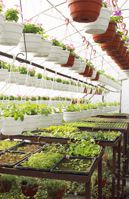Plants for the Water-Wise Garden
Plants for the Water-Wise Garden
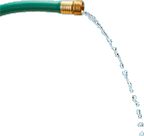
Landscaping with water-wise plants (often referred to as "xeriscaping") has become popular in recent years. The word xeriscape was first coined in the early '80s by Denver Water as the need for water conservation, particularly in the landscape, became increasingly important. Xeriscape (meaning "dry landscaping") became more than just a buzzword. However it was often associated with rock, sparse landscapes, cactus and yucca, and sometimes considered just plain boring.

Thirty years later landscaping with water-wise plants is anything but boring. Horticulturalists, gardeners, landscape designers, and plant enthusiasts have contributed considerable time and effort to developing an extensive list of water-wise plants that are suitable for use in the xeriscape garden. There is a wide variety of colorful, fragrant, and beautiful plants that require minimal irrigation. Many have long blooming seasons and attractive foliage. Some provide autumn interest with colorful foliage and fruit, while others offer winter interest with their fruit, seed stalks, structure, and winter colors ranging from silver, to gray, to shades of green, brown, and plum.
Important facets of the water-wise garden are shown below:
Selecting Water-Wise Plants
One key to successful water-wise landscaping is selecting plants that are adapted to local climate and site conditions. Ideally, you should select a plant palette of species native to your region. Over time, native plants are better able to adapt to the limits of their natural environment. They are perfectly suited to your climate and soil. These plants generally grow better, require less maintenance and use fewer inputs such as water, fertilizers, and pesticides. When choosing plants consider the following factors:
Climate
The trees, shrubs and other plants you select should be adapted to withstand the temperature and other climatic extremes in your region. Plants that can withstand cold, dry, winter winds in one region may succumb to root rot in wet, mild regions. A plant that is considered water-wise in an area that receives 30 inches of annual precipitation may not do well even with supplemental irrigation in arid regions. Determine your climate zone by going to the U.S. Department of Agriculture Plant Hardiness Zone Map. For the western U.S., use the more detailed Sunset climate zones map found in the Sunset Western Garden Book.
Microclimate
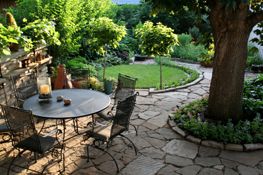
Consider the microclimates of your yard, such as sun or wind exposure and then select the appropriate plant for the appropriate place in your landscape. The orientation of your house and other structures will affect the microclimate of various locations in your yard.
Trees, shrubs, vines, and ground covers can also be used to change the microclimate of your yard, providing shade as well as reducing energy demand for heating and cooling. Plants also create microclimates that retain the moisture that would normally be lost through evaporation. Large trees and shrubs can provide shade and protection from the wind but may compete with smaller plants for available soil moisture. Your property has its own microclimate conditions.
Carefully note the sun, shade and wind patterns on your property over the seasons and choose plants that are suited for these conditions. Here are some additional tips on the selection and placement of trees and shrubs in your design that can beneficially change your yard's microclimate and provide significant energy savings:
- Plant trees to shade south- and west-facing windows, walls, and outdoor living spaces. A mature tree can reduce air-conditioning costs by more than 30 percent. Deciduous trees provide shade in summer, and in winter they allow the sun's warmth to pass through and warm your home and garden. Deciduous vines and shrubs can also be used with benefits similar to that of trees.
- Shade patios and seating areas during the hottest part of the day with trees or arbors planted with vines.
- Shade paved areas and air conditioners. Shading paved areas on your property will reduce the heat build-up. Shaded air conditioners don't work as hard to cool the air, providing further energy savings.
- Protect garden areas from drying winds. A row of trees or tall shrubs can buffer your property from strong winds that can cause unprotected soils and plants to dry out.
Water needs
Ideally, you should select plants that are adapted to local rainfall. Locally adapted plants will only need watering in order to get established or in times of severe drought. But it is not necessary to exclude all plants that will require regular irrigation from your design. Choose medium or low water using plants adapted to your climate and then group them in your landscape design according to their water needs (hydrozones). Medium water-use plants will require less supplemental water if they are situated in low lying or slow draining areas of the landscape provided the area is protected from wind and hot sun. Avoid locating low water-use plants adjacent to high water-use plants, such as turf, that require significantly more water. Select low water using perennial plants instead of annuals which have to be re-planted every year and generally require more maintenance and water.
Soil
Consider the soil preference of the plants you select. Some plants thrive in sandy soils while others prefer clay soils. In general plants that require more water do better in soils that have higher organic content; many xeriscape plants prefer leaner soils that are low in organic material. Soil pH can affect the availability of nutrients or the ability of certain plant diseases to thrive. Soil with higher levels of organic matter from hardwoods and conifers tend to have lower pH; arid regions are more likely to have alkaline soil. When in doubt have your soil tested. It is far easier to grow plants that are adapted to the soil conditions than to change the soil conditions to suit the plants.
Placement in the landscape
Know the mature size of the plants you select and make sure there is adequate space for them in your design when they are fully grown. Plants can be used to screen unsightly views or to create private spaces in the yard. Below is a summary of tips for the appropriate placement (or selection) of plants for your new landscape. These will result in water savings, reduced maintenance, and reduced costs.
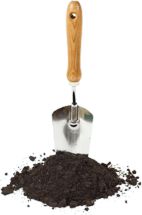
- Group plants in your landscape according to their water needs (as discussed above) - this will result in compatible plant groupings, and will enable you to water much more efficiently.
- Place plants preferring moist soils in areas that stay cool longer throughout the day - These include areas with afternoon shade, the north side of fences or structures, high water tables, and areas adjacent to water runoff.
- Place plants that prefer drier soils in areas that are more exposed to sun and wind - These include areas away from structures and shaded areas.
- Do not plant trees in your lawn - Lawns require more water to stay healthy, which can adversely affect the health and lifespan of the tree.
- Avoid narrow or oddly shaped lawns - Narrow strips of turf or irregularly shaped lawns are difficult to irrigate efficiently and generally result in overspray and runoff.
Types of Water-Wise Plants
What are the basic plant materials you have to work with?
Trees

Trees usually have the biggest design impact, and may be in your garden for generations. Trees may need supplemental water, especially in the arid West. Group trees together to shade each other and raise humidity levels, thereby reducing water demand. Trees will also create a "microclimate" for under-story plants that prefer cooler temperatures and shade (azaleas, camellias and rhododendrons, for example).
- Evergreen trees provide strong textural statements and are often used for screens and backgrounds. Plant in northern exposures and away from structures.
- Deciduous trees lose their leaves in winter. Plant deciduous trees on east, south, and west-facing walls to provide summer shade and winter sun.
- Do not plant trees in an irrigated lawn. Lawns require more water than trees, and over-watering trees can adversely affect their health and lifespan.
Shrubs
Shrubs range in height from 1-foot to 15-feet or more with multiple stems. There is a wide variety of shrubs adapted to all kinds of climatic conditions (dry to moist, hot to cold) and therefore offer many choices for your garden. Shrubs are ideal for making hedges to screen views, create privacy and can be used as "living fences." Many shrubs are fast growing and require little water once established. It is important to provide adequate space for the particular shrub variety selected so it can grow to its natural size and shape and not require excessive pruning or shearing.
Vines
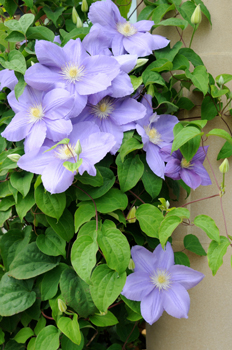
Vines provide an inexpensive screen with color and interest. They are usually grown on fences, or on arbors and trellises to provide shade. Most vines are deciduous although some are evergreen particularly in milder climates.
Perennials
Perennials such as daylilies, irises, and salvias come back year after year and are available in an almost infinite variety of flower colors and foliages. Plants are available that will grow in nearly all conditions in a wide variety of colors, form, shape, and size. They can be very water efficient and are the best bet for a colorful low maintenance garden. Arrange these plant types in groups of like species to create a mass effect. Place plants according to their mature width and height. If mixing varieties, they should have similar water needs.
Ornamental Grasses
Grasses provide a versatile choice for your garden and range in size from a few inches tall to over 20-feet (bamboo). They are tolerant of many conditions and will provide interesting structure, flowers, and winter form to your garden.
Ground covers
Ground covers will tie the plant layout together and can often be used in place of lawn. Ground covers can be used to stabilize the soil on a slope, reduce the effect of erosion, and provide cooling of the soil surface.
Lawn

Lawn provides aesthetic benefits and is good for active play areas, but it is also one of the highest water users in your garden. Limit your use of lawn - consider how much lawn you actually need and place it only where it will be used. Choose turf varieties most adapted to your climate. Warm season varieties use considerably less water than cool season varieties.
Annuals, herbs, and vegetables
Annuals, such as snapdragons and marigolds, last only one year as their name implies and must be replanted. They are also often high water users. Annuals are usually used in smaller garden beds as a focal point of seasonal color. Some herbs such as rosemary, lavender, and thyme are perennials and make excellent garden plants. If you want to grow vegetables, reserve an area with full sun, rich cultivated soil, and access to water.
Finding Water-Wise Plants

After you have considered these factors, visit your local botanic gardens, find local nurseries that specialize in water-wise plants, and stroll through your neighborhood to look for plants that use less water. Your university cooperative extension is also a great resource for information on locally adapted plants and many municipalities have demonstration gardens that feature water-wise plants. Many also provide basic information on a wide array of plants, including soil and climate preference, water needs and growth habits. Photos allow you to select plants based on aesthetic considerations such as foliage, plant shape, flower color, etc.
Choosing individual plants can be the most fun and rewarding part of designing your new landscape. The key to success is selecting the right plant for the right place in your landscape. Using trees, shrubs and other plants that are adapted to your regional climate and site conditions will help ensure success and save water.


